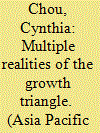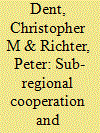| Srl | Item |
| 1 |
ID:
072725


|
|
|
|
|
| Publication |
2006.
|
| Summary/Abstract |
The Singapore-Indonesia-Malaysia Growth Triangle has been applauded by the governments of the three nation states, economists and transnational corporations as an economic success. However, other stark realities are evident at the local level as well. The Growth Triangle is supplanting older cultural and economic geographies. This has given rise to struggles over rights to territories and resources. Of the three points in the triangle, it is the landscape of Riau-Indonesia that has been transformed most dramatically. A comparative study of the cadastral maps of the administrators of the Growth Triangle versus the community maps of the indigenous peoples shows the differences in their perceived spatial ideas of Riau. It also highlights the different systems of knowledge as upheld by the administrators in contrast to that of the indigenous inhabitants. This comparative study brings to attention the issues of knowledge construction, mapping knowledge and the politics of mapping.
|
|
|
|
|
|
|
|
|
|
|
|
|
|
|
|
| 2 |
ID:
104129


|
|
|
|
|
| Publication |
2011.
|
| Summary/Abstract |
The Brunei-Indonesia-Malaysia-Philippines East ASEAN Growth Area (BIMP-EAGA) is one of a number of sub-regional "growth polygons" in Southeast Asia that was established in the early 1990s to help accelerate the process of regional integration among the member states of the Association of Southeast Asian Nations (ASEAN). However, these sub-regional zones include the less developed parts of Southeast Asia, and therefore face significant developmental challenges. This paper seeks to understand how BIMP-EAGA has addressed these challenges in accordance with the principles of developmental regionalism; that is, activities that are particularly oriented to enhancing the economic capacity and prospects of lesser-developed countries with a view to strengthening their integration into the regional economy, and thereby bringing greater coherence to overall regional community building. This article examines how BIMP-EAGA has pursued developmental regionalism through various initiatives and measures aimed at enhancing inter-related development capacities: technocratic, institutional, industrial, infrastructural, human and sustainable development. There have been successes but also failures in BIMP-EAGA, as evidenced by the persistent lack of progress in achieving substantial sub-regional development cooperation. This paper discusses the reasons for these outcomes, and makes a number of recommendations to give BIMP-EAGA new direction and purpose.
|
|
|
|
|
|
|
|
|
|
|
|
|
|
|
|